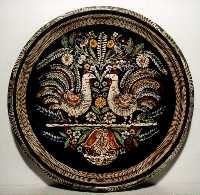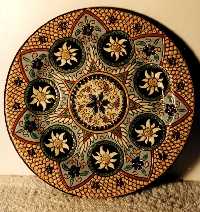Thoune Pottery Majolika
In the 18th -19th century clay pottery was produced in
the village Heimberg near Thune for daily use. Manufacturing declined as the
stronger porcelain replaced the clay pottery. With the upcoming tourism this
development was halted. Tourists purchased old rich decorated "Heimberg"
pottery or faience’s from the Simmental as souvenirs, the interest was so
high, that new art-pottery was made to satisfy the demand. The Antique shop Born
in Thun sold antic pottery of the Simmental in the last century.
 Plate by Abraham Marti 1763 St. Stephan, Simmental, 25 cm
Plate by Abraham Marti 1763 St. Stephan, Simmental, 25 cm
So many English homes were decorated with such plates and today good quality
objects can still be found in England or France.
There are three distinctive phases in the development of this pottery. The
early phase 1800 - 1860, called "old Heimberg" was still pottery for daily
use, but richly decorated.
 Rösti plate 1840, 35 cm
Rösti plate 1840, 35 cm
The "Paris Ware" 1860 - 1880, named after the World Exhibition in Paris 1878.
This style of decoration consists mainly of flowers on dark background; the
Edelweiss was not yet used. Sales Companies "F. Wunderlich & Son" or
"Schoch-Läderach" exported such pottery to Paris and sold it there.
 Paris Vase, one of a pair shown, dated 23.7.1878, h 26 cm
Paris Vase, one of a pair shown, dated 23.7.1878, h 26 cm
The pottery of the last phase 1881 - 1914 is often marked as "Thoune" and is
decorated with geometrical patterns and Edelweiss flowers (Majolika). This
phase evolved together with increasing tourist numbers, sales stands in the
newly established hotels and production in "Manufakturen".
 Majolika plate, signed Wanzenried, 19 cm
Majolika plate, signed Wanzenried, 19 cm
The flourishing arts and crafts business also created new partnerships between
them. As a result of this, oil painted plates were produced.
 Wetterhorn, plate sigend by Wanzenried, 48 cm
Wetterhorn, plate sigend by Wanzenried, 48 cm





